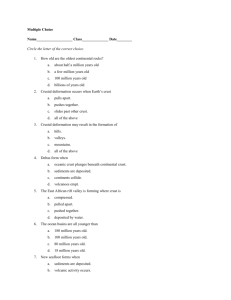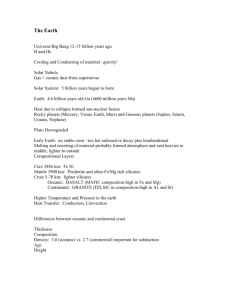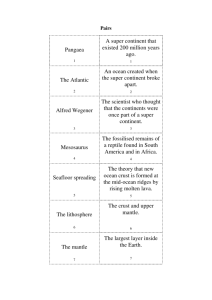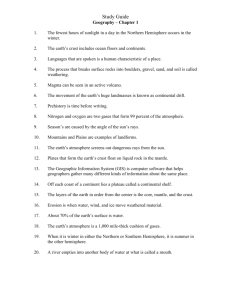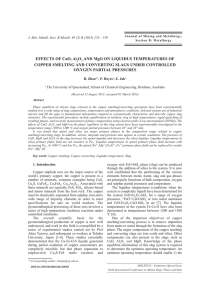Earth History GEOL 2110
advertisement
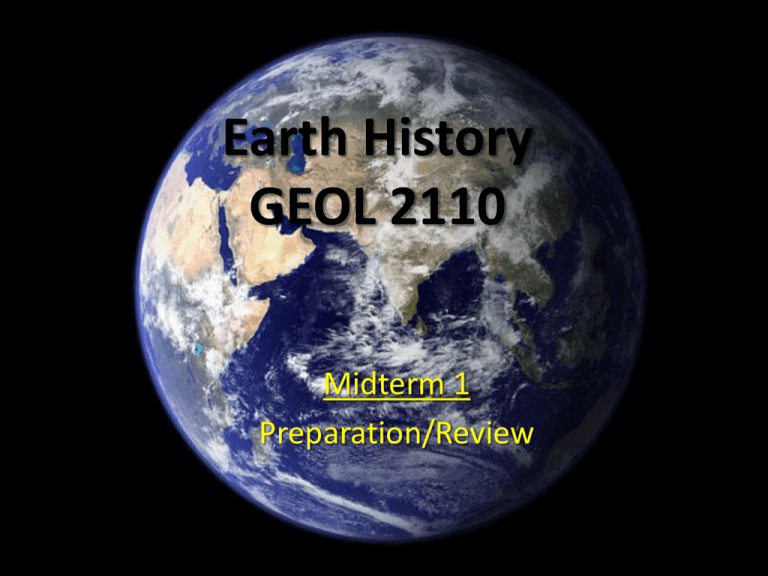
Earth History GEOL 2110 Midterm 1 Preparation/Review Style of Questions • Matching term w/ definition, person w/ notable accomplishment • Short definition of concepts/processes • Name some of multiple characteristics REVIEW PowerPoints!! Understand Figures in Text. Dramatic vs. Subtle Geological Events Be able to give examples of each Scales of Geologic Time Important People and their Contributions to Geological Concepts Leonardo Da Vinci Nicholas Steno Georges L. Buffon A.G. Werner James Hutton Cuvier & Brongniart William Smith Lamarck Charles Lyell Charles Darwin Gregor Mendel Lord Kelvin Hall and Dana Alfred Wegener Geological Concepts and Principles Concepts Principles • Cosmogony • Superposition • Neptunism • Original Horizontality • Plutonism • Lateral Continuity • Catastrophism • Walther’s Law • Uniformitarianism • Fossil Correlation • Actualism • Index Fossils • Evolution by Natural Selection • Continental Drift and Sea-floor Spreading Characteristics of a Scientific Theory • Based on facts, but not a statement of certainty or truth • Testable – holds up to repeated testing • Predictive – forward and backward in time • Explains many related natural phenomenon • Deemed by a majority of scientists to have a high probability of being correct Know the differences between a hypothesis, theory, and paradigm On the Origin of Species Know Darwin’s 5 principle areas of evidence that support his theory of Evolution by Natural Selection Genetic Theory The Mechanism behind Evolution Categories of Stratigraphic Units (Fundamental Units) and Relative Time Lithostratigraphic (formation) – principle of superposition Lithodemic (intrusion) – principle of cross-cutting relationships Biostratigraphic (biozone) – principle of fossil correlation Magnetopolarity Pedostratigraphic Allostratigraphic Types of Unconformities and Regional/Global Time Markers Absolute Age Dating Understand the meaning of: • element vs. isotope • radioactive vs. stable isotope • types of radioactive decay • parent vs. daughter isotope • decay rate of a radioactive isotope • half-life of a radioactive isotope The Solar Nebula Theory Seismic Imaging the Deep Earth Layers of the Earth OCEANIC CRUST CONTINENTAL CRUST SiO2 47% 56% Al2O3 16% 18% FeO 13% 9% MgO 10% 3% CaO 10% 4% Na2O 2% 5.5% K2 O 0.7% 2.5% TiO2 1.1% 1.3% P2O5 0.2% 0.7% MANTLE SiO2 – 45% MgO – 37% CORE Fe – 86% S – 10% Ni – 4% FeO – 8% Al2O3 – 4% CaO – 3% others – 3% ---Mohorovicic Discontinuity = chondritic meteorites Compositional Layers Physical Layers Continental Crust Distillation of Ocean Crust by Partial Melting Evidence in Solid Solution Minerals OCEANIC CRUST CONTINENTAL CRUST SiO2 47% 56% Al2O3 16% 18% FeO 13% 9% MgO 10% 3% CaO 10% 4% Na2O 2% 5.5% K2 O 0.7% 2.5% TiO2 1.1% 1.3% P2O5 0.2% 0.7% Present-day Formation of Crust A Double Distillation Process Melting the Mantle Makes Mafic Magma – ALWAYS Melting Crust Makes Intermediate to Felsic Magma Evidence of Plate Tectonics Fit of the continents Fossil record indicating former land bridges Similar geologic structures Similar paleoclimates Apparent polar wandering of continents Topography of the seafloor Magnetic polarity “striping” of seafloor Distribution of volcanoes and mountains Distribution of earthquakes (Benioff zones) Young age of the seafloor Age distribution of volcanic islands Types and Features of Plate Boundaries
